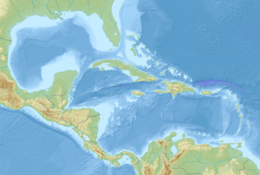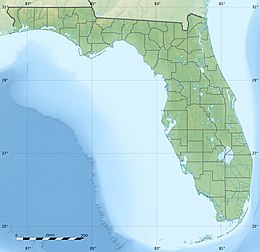2006 Gulf of Mexico earthquake
| UTC time | 2006-09-10 14:56:08 |
|---|---|
| ISC event | 8659780 |
| USGS-ANSS | ComCat |
| Local date | September 10, 2006 |
| Local time | 10:56 EDT |
| Duration | ~ 20 seconds [1] |
| Magnitude | 5.9 Mw |
| Depth | 14 km (9 mi) [2] |
| Epicenter | 26°15′N 86°38′W / 26.25°N 86.63°W [2] |
| Type | Reverse[2] |
| Areas affected | Southeastern United States |
| Max. intensity | MMI IV (Light) |
| Casualties | None |
The 2006 Gulf of Mexico earthquake occurred in the eastern
Characteristics
The quake was reportedly felt along the gulf coast and as far north as Georgia. The earthquake was the strongest in the Gulf of Mexico in 33 years and was an intraplate earthquake, an event that takes place away from the borders of tectonic plates (where most tectonic activity takes place). Earthquakes in the Southeastern United States are not common, but several strong events have occurred in the region. In 1879 close to St. Augustine, Florida an earthquake damaged plaster and forced dishes off counters, and in South Carolina the 1886 Charleston earthquake caused severe damage and was responsible for the deaths of sixty people.[3]
The event occurred near the Cuba Fracture Zone and was well away from the edge of the North American Plate. Randy Cox, an associate professor of earth science at the University of Memphis in Tennessee stated that the source of strain was the Mid-Atlantic Ridge, where seafloor spreading was causing compression of the North American Plate. A magnitude 5.2 event in February 2006 may have been associated with the same fault zone.[3]
The epicenter of the earthquake was too far offshore for it to be well covered by onshore seismographs and the event's characteristics are therefore poorly constrained. The focal mechanism indicated reverse faulting. The focal depth of between 14–31 km show that it occurred within the seismogenic zone, rather than on any of the many shallow growth faults in the area. The earthquake led to a reassessment of the geohazard for hydrocarbon exploration and production facilities in the Gulf.[4]
Several thousand people reported the event to the
See also
References
- ^ a b "Shock Waves Felt in South After Gulf Quake", The New York Times, Associated Press, September 11, 2006, retrieved September 29, 2012
- ^ a b c USGS (September 4, 2009), PAGER-CAT Earthquake Catalog, Version 2008_06.1, United States Geological Survey, archived from the original on 2020-03-13
- ^ National Geographic News, archived from the originalon October 20, 2006, retrieved September 29, 2012
- ^ Angell, M.; Hitchcock, C. (2007). "A Geohazard Perspective of Recent Seismic Activity in the Northern Gulf of Mexico" (PDF). Offshore Technology Conference. Archived from the original (PDF) on 2012-04-26. Retrieved 7 December 2011.
- ^ "Earthquake Summary". United States Geological Survey. Archived from the original on October 14, 2006. Retrieved September 11, 2006.
External links
- The International Seismological Centre has a bibliography and/or authoritative data for this event.



